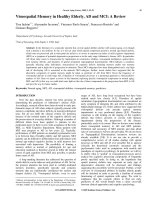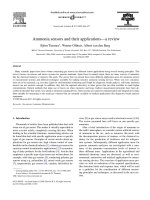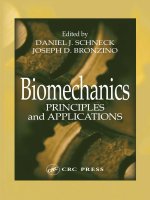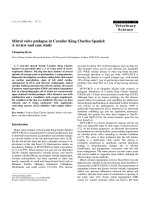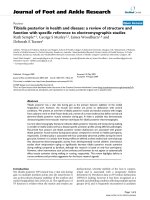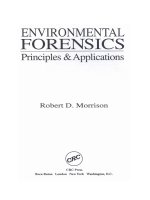Transgenesis in animals: Principles and applications – A review
Bạn đang xem bản rút gọn của tài liệu. Xem và tải ngay bản đầy đủ của tài liệu tại đây (231.07 KB, 10 trang )
Int.J.Curr.Microbiol.App.Sci (2018) 7(10): 3068-3077
International Journal of Current Microbiology and Applied Sciences
ISSN: 2319-7706 Volume 7 Number 10 (2018)
Journal homepage:
Review Article
/>
Transgenesis in Animals: Principles and Applications – A Review
Sheikh Firdous Ahmad1*, Kanika Mahajan2, Tania Gupta3,
Maliha Gulzar4 and Vandana Yadav5
1
Division of Animal Genetics, ICAR-Indian Veterinary Research Institute,
Izatnagar, Bareilly (UP) - 243 122, India
2
Division of Livestock Products Technology, FVSc & AH, SKUAST-J, Jammu - 180 009, India
3
Department of Veterinary Microbiology, Dr GC Negi College of Veterinary and Animal
Sciences, Palampur, Himachal Pradesh - 196 062, India
4
Department of Veterinary Public Health, FVSc & AH, SKUAST-K, Shuhama, Srinagar,
J&K - 190 006, India
5
Animal Genetics & Breeding Division ICAR-National Dairy Research Institute Karnal,
Haryana - 132 001, India
*Corresponding author
ABSTRACT
Keywords
Ethics, Regulation,
rDNA, Transgene,
Xenotransplantation
Article Info
Accepted:
24 September 2018
Available Online:
10 October 2018
Transgenesis refers to the technique involving the manipulation of genes of one organism
and deliberate addition into the genome of another organism of same or other species and
sometimes specific inhibition of endogenous gene inhibition. Transgenesis promises to
solve different problems. The animals produced through the process of transgenesis will
serve us various purposes from medicinal to commercial uses. Different methods of
producing transgenic animals are available; however, their effectiveness varies with
species involved. Various kinds of transgenic animals have been produced to date.
However, few issues related to ethics and regulations of transgenic animals remain to be
addressed. In this review, we tried to cover the basics of transgenics to understand their
promise in the livestock world.
Introduction
With an ever-increasing population, there is
increased pressure on available food resources
and a constant threat to the food security. With
shrinking agricultural land along with the
recent figures and reports showing huge
numbers of malnourished and starved people
all over the world, the problem is escalating.
Presently, as per the global organization
(WHO) figures, over 795 million people are
undernourished all over the world (FAO,
2015). On one hand, the revolutions in terms
of green and white ones during the early 70s
and 80s have already reached their ceiling
effects. At the other side, conventional
breeding programmes have inherent problems
such as being time-consuming and difficult to
implement.
Furthermore,
conventional
breeding is possible only between individuals
of same or closely related species because of
different reasons (including mechanical,
3068
Int.J.Curr.Microbiol.App.Sci (2018) 7(10): 3068-3077
temporal
and
behavioural
isolation
mechanisms). In some species, it may take 510 years (sometimes, even 20 years) to make
up one generation and that is too much of a
burden in the present world.
Intervention,
through
biotechnological
techniques, seems to be an apparent answer to
majority of these problems. The field of
genetic engineering started long back in the
1980s but has, thereafter, progressed at a rapid
pace. Biotechnological research is important
as our response to ever-increasing pressure of
the growing population as it will certainly help
in relieving some pressure off these unspoken
creatures. Transgenesis holds the promise to
cover the inadequacies of conventional
breeding programmes. Transgenesis refers to
the technique involving the manipulation of
genes of one organism and deliberate addition
into the genome of another organism of same
or other species and sometimes specific
inhibition of endogenous gene inhibition
(Shankar and Mehendale, 2014). This addition
should be in a specific way that the genes thus
introduced are not only introduced but also
transmitted to the next generation(s).
Recombinant DNA (rDNA) technology is an
associated technology used to separate and
construct the gene of interest producing the
desired trait in the recipient animal (Shankar
and Mehendale, 2014). When a gene construct
gets integrated and inherited into the genome
of recipient organism, it is called a transgene
and the coded product (whether protein or
others) thus produced is known as the
transgenic product. In this review, we tried to
give a basic understanding of various aspects
of transgenesis in livestock from its theoretical
to practical aspects.
Transgenesis: Solution to problems
The very biochemical composition of DNA
and its regulation is manifested to be the same
in all eukaryotic species (Magnus and Lali,
2008). Thus, intermingling the genetic content
and producing a virtual mosaic is possible
now. The exhaustive work is done in genetics,
genomics
and
other
branches
of
biotechnology, particularly the result of
human genome project (along with its
extension to other fields) opened vast areas in
medical research in combination with
transgenics (Jaenisch and Mintz, 1974).
Transgenesis brought, with it, a revolutionary
technology that involves introducing new
genes to a species, which belong to an entirely
different species (Magnus and Lali, 2008). In
fact, with this technology, the door for gene
transfer even across different kingdoms is
possible. It promises to open vast areas into
the scientific world and this ultimately will
have a positive impact on human welfare
(Melo et al., 2007).
Transgenesis in livestock
The use of genetic engineering for the
improvement of livestock was pioneered by
Palmiter et al., (1982). Though the initial
success of this technology in terms of
transgenesis was obtained in laboratory animal
mice in 1974 by Jaenisch and colleagues, the
success in larger animals was obtained only in
1997 when first successful transgenic cattleRosie, was generated (Clarke, 2002).
Through genetic engineering, it is possible to
make specific alterations to animals‟ genome
that seems and is impossible to achieve
through conventional selective breeding. In
the present scenario, we easily think of
manipulating the properties of animals; be that
with meat, milk, egg, wool, excretory
products, other behavioral, psychological,
physiological or any other responses (Pusta,
2011). In fact, one of the first applications of
these transgenically produced large farm
animals was that they could produce altered or
novel proteins in their milk (Van Berkel et al.,
2002)
3069
Int.J.Curr.Microbiol.App.Sci (2018) 7(10): 3068-3077
The process of transgenesis with the
production of transgenic animals promises
following general advantages:
Increased growth rate in meat animals (Beef,
pigs, chicken, etc)
Increased muscle mass
Increased feed conversion rates
Improved nutritional quality
Increased disease resistance in animals
Improved wool quality
Disease models
Xenotransplantation
Bioreactors
However, with transgenesis, it is not the end
for conventional animal breeding procedures,
but these two processes will need to be taken
in conjunction for better animal production.
These aspects include that of feed
optimization, reproductive improvement,
disease control, efficient production alongside
other common goals (Houdebine, 2002).
Methods
animals
of
production
of
transgenic
The establishment of stable transgenic animals
obviously implies that the foreign DNA is
inserted and gets transmitted to the
progeny(ies). To serve this purpose, the
transgene needs to be integrated into gametes
or one-cell embryos. Initially, only a few
methods of production of transgenic animals
were available; however, considerable
progress has already been made in these
methods as many methods are now available
with the scientists. The production of
transgenic animals embarked with the method
of pronuclear microinjection over 20 years
ago. New methods followed it, including those
of viral vectors, sperm-mediated gene transfer
and somatic cell cloning. Each new method
has added a feather and helped to overcome
many of the limitations of earlier methods.
Different methods of production are preferable
in different animal species. It seems now
relatively easy to readily make simple
insertional genetic modifications into these
animals‟ genome. Following is a brief account
on main methods for production of transgenic
animals:
DNA Microinjection
This method includes the direct DNA
microinjection into the pro-nuclei of embryos
and was the first documented technique that
helped in the initiation of transgenesis
concept. As this remained the only protocol in
earlier times, it was followed in all species of
animals and results differed with a decreasing
yield in terms of successful animals produced
from mouse to cow. Large farm animals
including bovine animals have a slow
reproduction rate and the embryo generation
under superovulation is comparatively low.
The success seemed accessible only after invitro preparation cum maturation on matured
oocyte if embryos were prepared in vitro after
oocyte maturation and fertilization followed
by in vitro development of the microinjected
to the blastocyst stage (Krimpenfort et al.,
1991). The method is laborious and costly and
its success in various species remains variable
due to unknown reasons. The first transgenic
livestock was produced in 1985 by
microinjection of foreign DNA into zygotic
pronuclei.
The use of transposons
In several animal species, it may be difficult to
integrate injected foreign DNA from the
cytoplasm directly into the genome. It remains
to be the main problem associated with
producing transgenic poultry. Intended to
counter this limitation and increase the
frequency of integration, several tools and
techniques were tried and implemented from
time to time. One way of making this a reality
is by generating breaks in host DNA. This is
3070
Int.J.Curr.Microbiol.App.Sci (2018) 7(10): 3068-3077
done by injecting low amounts of restriction
enzymes that help cut it at specific regions.
The DNA repair mechanism restores DNA
and integrates the foreign DNA into the
genome of an animal. This method is
analogous to gene editing in cells for various
purposes wherein the inherent repair
mechanism of cells is exploited. Low
concentrations of restriction enzyme have no
significant effect whereas the same is not true
with the higher enzyme concentrations.
of complete organism. Embryonic stem cells
are used for more accurate alterations of the
mouse genome. This technique allows
insertion, removal or modification of DNA
sequences.
Knock-out,
knock-in
and
conditional mutant mice are produced with
this method (Buy, 1997). The mouse produced
initially from such cell injections is a genetic
chimera composed of embryonic stem
derivatives and cellular descendants of the
blastocysts into which the embryonic stem
cells are inserted.
Retrovirus-mediated gene transfer
Lentiviral Transfer of Oocytes and Zygotes
The success rate of transgenesis by any
method has been limited due to the efficiency
of gene transfer. Among the several gene
transfer systems available, retrovirus-mediated
gene transfer has been highly efficient
(Nowrouzi et al., 2011). Retroviruses are used
as vectors to transfer gene efficiently due to
their affinity and infectivity for certain target
cells
resulting in
successful transgene
incorporation (Koo et al., 2014). Retrovirus
transfers genetic material in the form of RNA
into the host cells resulting in the generation
of chimera. The chimeras are thereafter inbred
for nearly 20 generations to obtain
homozygous transgenic offspring which
carries the desired transgene in each cell
(Manmohan and Niraj, 2010). This method
was used successfully in the production of
transgenic mice in 1974 using the simian
virus.
Embryonic stem cell-mediated (ESC) gene
transfer
The ESC method involves prior insertion of
the target DNA sequence into in vitro culture
of embryonic stem cells by homologous
recombination.
Embryonic
stem
cells
are pluripotent and derived from the inner cell
mass of a blastocyst that has the potential to
differentiate into any type of cell such as
somatic cells and hence leads to the creation
This method helps overcome the drawback of
viral-mediated gene transfer which includes
silencing of the transgenic locus and low
expression levels. An example includes the
generation of transgenic cattle by lentiviruses
involves microinjection into the oocytes
(Hofmann et al., 2004). In this, lentivirusbased vectors used can infect non-dividing
cells, carry large amounts of the transgene
(10kb) and depict stable expression in the
tissue in which they are incorporated. This
technique has shown successful results with a
100 fold increase in the level of transgenesis
(Sang, 2004).
Potential, promises and concerns
Transgenesis in the animal world (and other
fields) continues to excite and elicit
excitement in scientifically tempered minds. It
is one of the most potent and exciting fields of
the present biological sciences. It promises to
provide pivotal tailored models for various
kinds of research that are ultimately aimed at
the welfare of society as a whole (through its
various uses). They also have the potential to
answer and address some special biological
problems. The use of transgenic animals also
promises us to decipher complex biological
process and systems that may have hampered
our progress until now (Pinkert, 2014). The
3071
Int.J.Curr.Microbiol.App.Sci (2018) 7(10): 3068-3077
use of transgenesis process is itself of
immense significance in those animal species
whose life cycle and generation interval
reduces the effectiveness of conventional
breeding practices for rapid genetic
improvement.
Transgenic animal models once prepared shall
provide us with to provide us the scope for
unimaginable control over the genetic makeup
of an organism/animal aimed eventually to
visualize varied gene products (Shankar and
Mehendale, 2014). Due to this unprecedented
property and versatility of transgenic models,
they are presently the mainstay of biomedical
and research landscapes. It emerges out to be a
well-established fact now that transgenesis is
one of the prime tools of biologists to study
gene expression and function. Transgenesis is
extensively and systematically being used in
the identifying and deciphering the function of
different human genes. The technique of
transgenesis promises a helping hand in many
aspects of biological sciences including
genetic research, epigenetic studies, immune
and cancer research, pharming, biomedicine
and agriculture along with various other fields.
Scientific studies on systems of neurology,
cardio-vascular system, thyroid function and
dysfunction,
intermediary
metabolism,
hemoglobin switching and reproduction are
some other fields where transgenic animals are
of
immense
help
(Blundell,
2006)
Furthermore, it will undoubtedly help in the
genetic improvement of our livestock
(Wheeler et al., 2003).
Transgenic animal production is aimed to
produce models for various diseases including
genetic/developmental defects, neoplastic,
metabolic, nutritional, degenerative and
infectious ones (Blundell, 2006). The very
productive and efficient application of
transgenesis in the animal world has opened
vast areas into our understanding of the gene
function and regulation (Wolfgang, 2016).
While most of the research till very recent
times was restricted to be done on mice and
other lab animals, now this is sure to extend to
other complex biological systems of large
animals. Transgenic farm animal models for
various diseases are said to provide better
models than genetically modified animals like
mice and rats.
The diseases, affecting the human population,
for which successful models have been
prepared, are sickle cell anemia, prostatic
hyperplasia, diabetes mellitus, retinoblastoma,
learning impairment and cystic fibrosis
(Blundell, 2006). Transgenic rabbits are being
used in research and studies on the disease
known to us as atherosclerosis. This ultimately
will help in basic understanding and
mechanism studies on this disease (Taylor,
1997). Transgenic non-human primates i.e.
Monkey, similar to humans in various aspects,
is used in clinical trials for HIV and
Huntington‟s chorea (Yang et al., 2008).
Presently the species for which transgenic
varieties have been prepared are mice, goat,
sheep, chicken, cow, horse, dogs, fishes,
swine, monkeys and various other ones (Clark
and Pazdemik, 2016). It is nothing but
obvious, that these transgenic animals fulfill
various purposes to their producers, caretakers
and society as well. Milk, meat, egg white,
blood, urine, seminal plasma, silkworm
cocoon along with others form preferred
routes to be the source(s) of recombinant
proteins at commercial scale (Houdebine,
2002). On one side, a transgenic cow produces
milk with increased casein content in it and on
the other hand milk from goat has increased
anti-thrombin content which is extremely
useful in hemophiliac individuals and several
other conditions (Umaraw et al., 2015). Some
other instances of transgenic animals include
that of transgenic sheep „Tracy‟ being aimed
for efficient and woolier output.
3072
Int.J.Curr.Microbiol.App.Sci (2018) 7(10): 3068-3077
Table.1 Transgenic animals produced to date along with their uses
S. No
2.
TRANSGENIC
ANIMAL
Ruppy
(The Glowing
transgenic Puppy)
Spider-goat
3.
Enviropig
4.
Herman
(Transgenic Cow)
5.
ANDi
(Transgenic
Monkey)
Salmon
(Transgenic fish)
1.
6.
Transgenic Mice
Marathon Mouse
7.
8.
Oncomouse
9.
Mighty Mice
10.
AIDS mouse
11.
Alzheimers mouse
12.
Youth Mouse
13.
Smart
Mouse/Doggie
USE
Scientist/University
Model to study human diseases.
Byeong-Chun Lee (Seoul
National University in South
Korea)
Randy Lewis (University of
Wyoming)
Spider silk protein in its milk is
used in various products such as
artificial ligaments, wound
dressings, body armor, implantable
optical systems for medicine.
To mitigate the problem of manure
based environmental pollution by
efficiently utilizing plant
phosphorus.
Produces human protein lactoferrin
in its milk that can be useful in
developing various medications.
Biological model of research and
thus useful for curing of nearly
ineffable diseases.
Grows rapidly with the ability to
continuously produce growth
hormone.
Useful in designing drugs that
enhance muscle development and
mimic all the merits of exercise.
Useful test subjects for cancer
research
Model to study various aspects of
ageing.
Model to study and develop a cure
for HIV infection.
To develop vaccine against
Alzheimer‟s disease.
Model to study ageing, diets and
clot dissolution.
Gene inserted improves the
memory of mice which could be
beneficial to the society in near
future.
3073
Meidinger et al., 2013
(University of Guelph)
Gen Pharm International
A. W. S. Chan and his
colleagues (Oregon Regional
Primate Research Center)
Devlin et al., 2001.
Howard Hughes Medical
Institute
Philip Leder and Timothy
Stewart(Harvard University)
Dr. Richard Hanson (Case
Western University)
Researchers at the University
of Maryland(2001)
Joint efforts of researchers at
Worcester polytechnic
institute and Transgenic
Sciences Inc.(1995)
Researchers of Weizmann
Institute of science
Researchers at Princeton
University
Int.J.Curr.Microbiol.App.Sci (2018) 7(10): 3068-3077
With transgenesis, cows are now known to
produce more milk or milk with an altered
composition such as less lactose or
cholesterol; pigs and cattle have more meat on
them that is also rapidly growing and sheep
get woolier. Pigs with the intentional addition
of human IGF 1 produce 30 percent more loin
mass, 10 percent more carcass lean tissue and
20 percent less carcass fat (Pursel et al.,
2004). “Healthy Pork” is produced from
transgenic pigs that carry a gene from plant
origin and this pork has increased amount of
unsaturated fatty acids (which is not present
normally in them) in it (Niemann, 2004)
Transgenic animals are also potentially useful
in the production of various medicines,
nutritional supplements and pharmaceuticals
besides several other uses. With the combined
use
of
nutritional,
genetic
and
biotechnological concepts, researchers have
gained significant success in the production of
„medicine milk‟, that will be rich in specific
milk components. This, in turn, will have
significant implications for health and
treatment aspects. Ruminants such as cows,
goats and sheep are being utilized for the
production around 60 therapeutic proteins
including those of plasma proteins,
monoclonal antibodies and vaccines (Masih et
al., 2014)
Another instance of transgenesis being helpful
to humans is that of transgenic pigs that are
very
useful
in
the
process
of
xenotransplantation. They can donate
different organs with minimum complications
and efficient results (Melo, 2007). They are
also used in the study of human co-factor
proteins. Livestock species have long
provided tissues or tissue extracts for
treatment of human illness. Pig hearts, for
example, have provided valves for
transplantation. The transgenic approach has
embarked several possibilities with it in
providing tissues or tissue extracts for
transplantation into humans. Swanson et al.,
(1992) documented research shows the
production of functional human hemoglobin
in transgenic swine, although a number of
limiting factors exist. These organ(s) from
transgenic animals are so modified that no
host immune response is elicited, and thus no
problem of rejection occurs.
In the pharmacy sector, with genetic
engineering and transgenesis, the gene
responsible for any drug of interest can be
transferred into other desired animal that will
produce large amounts of that drug. This
technology is popularly known as pharming
that involves the production of human
pharmaceuticals from animals on a large
scale. With gene “Pharming”, we are able to
produce recombinant and biologically active
proteins in various organ systems of
transgenic animals. In transgenic ruminants,
the milk secretion route from the mammary
glands is most preferable and used. The
quality of protein(s) that are produced in this
organ is efficient as there are specific
promoter elements and methods are
established for extraction and purification of
those proteins (Magnus and Lali, 2008).
Preparation of biochemical and other
hormones is also underway, which is mostly
targeted to produce some important hormones
such as insulin, growth hormone and blood
anti-clotting factors. Variable progress has
already been made in the production of these
products from transgenic cows, sheep or goats
and others. Research is also underway to
target to counter other diseases like
phenylketonuria
(PKU),
hereditary
emphysema, and cystic fibrosis by applying
the path of transgenesis.
Production of monoclonal antibodies is
another important aspect of transgenic
animals. Numerous monoclonal antibodies are
being produced from the mammary gland of
transgenic goats. Transgenic cattle produce
3074
Int.J.Curr.Microbiol.App.Sci (2018) 7(10): 3068-3077
specific recombinant bispecific antibodies in
their blood. The stable antibody thus purified
from blood mediates target cell restricted T-cell
stimulation and tumor cell killing.
An exotic protein in the form of spider silk, that
is known to possess exceptional mechanical
properties, has recently been obtained from
mouse milk (Karatzas et al., 1999). In the
production of silk-producing goats, scientists
added cells originated from silk spiders to the
genome of goats. The transgenic goats thus
formed started producing strands of silk in their
milk. The silk is strong, lightweight and is used
to make clothing and other items. Spider silk is
described as “ancient biomaterial of the future”
by Professor Randy Lewis of Utah State
University. In the medical field, research work
suggests that spider silk is virtually invisible to
our immune system and it thus won‟t reject it.
This, in turn, makes spider silk, due to its elastic
and tensile properties, a perfect substitute for its
use as artificial tendons, cartilage and ligaments
as well as suture material and sealants. In
warfare, a layered piece of rubbery silicon with
about 10 layers of spider silk painted on it was
seen enough to stop a bullet because of its
incredible absorbent qualities for dissipating
impact and shock. Spider silk also finds uses in
various other fields.
Still, the question remains which animal to be
used for the purpose of transgenesis or else if all
animals are the same in this regard? Variation
amongst various mammalian species is distinct
in terms of size and other parameters and
several of them have been successfully
manipulated to produce recombinant proteins in
their milk. Small ruminants such as sheep and
goat have emerged as the best animals for the
production of proteins up to several tons per
year. The pig now stands confirmed as living
fermentor although milk cannot easily be
collected from it as in ruminants. The rabbit is
said to produce about 200-250 ml of milk per
day that is rich in protein. Transgenic rabbits
are easy to produce and at a relatively low cost.
Rabbits are prolific breeders and are fit for
production of recombinant proteins not
exceeding 1 kg per year. On the other hand,
transgenic cattle bear a potential to produce 400
tons of human albumin per year (Blundell,
2006). Table 1 summarizes the different
transgenic animals produced to date along with
their uses.
However, the field of transgenesis is not a
perfect science and does not come without any
negatives. It is seen in a certain number of cases
that recombinant proteins produced from some
organ systems pose deleterious threats, for say to
mammary gland function, or to the animal as a
whole. These effects may be visible in the
present or the future aspects of the life of an
animal. These effects are mainly attributed to
some form of ectopic expression of the
transgenes and to the probable transfer of
recombinant proteins from milk to blood or other
connecting systems. One documented possibility
to counter and/or reduce these deleterious effects
is to use induction molecules for the systems
such as tetracycline. This will eventually allow
transgenes to be expressed only during certain
specified physiological period say lactation
period and will also strictly limit its expression
into one system only say mammary gland. The
procedure of these recombinant proteins is
generally not very difficult, particularly from
milk. This, however, may not be the situation
with endogenous proteins such as serum albumin
or antibodies that are present abundantly in milk.
The physiological occurrence of these proteins in
the blood may be a crucial factor for creating
problems with their production. Among the
various biological contaminants potentially (not
always and not proven) present in some
recombinant proteins from transgenic animals,
prions are certainly those raising the major
concern. Besides these, there are several legal,
ethical and social issues that are an integral part
of transgenesis and associated with its
introduction in the livestock world. These
ethical, legal and social aspects of
biotechnological research need to be addressed
before the implementation of transgenic herds.
Overexpression and unregulated expression are
other concerns associated with the field of
transgenesis.
3075
Int.J.Curr.Microbiol.App.Sci (2018) 7(10): 3068-3077
It may well be concluded that the field of
transgenesis has developed rapidly and
promises to solve many problems of the present
world. Its applications in livestock are immense
but word of caution is important. Before the
commercial application in regulated mode, few
issues (such as legal and ethical issues) will
need to be addressed.
Acknowledgements
The authors would like to thank ICAR to
provide the necessary facilities and JRF
fellowship during this study.
Conflict of interest
The authors declare no conflict of interest for
this manuscript
References
Blundell, R. 2006. Transgenic Animals-Review
Paper. Journal of Animal and Veterinary
Advances, 5(11), 935-938.
Buy, M. 1997. Transgenic Animals, Animal
Welfare and Ethics, Canadian Council on
Animal Care (CCAC). Retreived from
/>lines.html/.
Clark, D. P. and Pazdernik, N. J. 2016.
Nanobiotechnology. Biotechnology, 219248.
Clarke, A. R. 2002. Transgenesis techniques:
principles and protocols (Vol. 180).
Springer Science & Business Media.
Devlin, R. H., Biagi, C. A., Yesaki, T. Y.,
Smailus, D. E. and Byatt, J. C. 2001.
Growth of domesticated transgenic
fish. Nature, 409(6822), 781.
FAO, I. (2016). WFP (2015), The State of Food
Insecurity in the World 2015. Meeting the
2015 international hunger targets: taking
stock of uneven progress. Food and
Agriculture Organization Publications,
Rome.
Hofmann, A., Zakhartchenko, V., Weppert, M.,
Sebald, H., Wenigerkind, H., Brem, G.
and Pfeifer, A. 2004. Generation of
transgenic cattle by lentiviral gene
transfer
into
oocytes. Biology
of
Reproduction, 71(2), 405-409.
Houdebine, L. M. 2002. Animal transgenesis:
recent
data
and
perspectives. Biochimie, 84(11),
11371141.
Houdebine, L. M. 2002. Transgenesis to
improve animal production. Livestock
Production Science, 74(3), 255-268.
Jaenisch, R. and Mintz, B. 1974. Simian virus
40 DNA sequences in DNA of healthy
adult mice derived from preimplantation
blastocysts
injected
with
viral
DNA. Proceedings of the national
academy of sciences, 71(4), 1250-1254.
Karatzas, C. N., Zhou, J. F., Huang, Y.,
Duguay, F., Chretien, N., Bhatia, B. and
Wang, B. 1999. Production of
recombinant spider silk (Biosteel TM) in
the
milk
of
transgenic
animals. Transgenic Res, 8, 476-477.
Koo, B. C., Kwon, M. S. and Kim, T. 2014.
Retrovirus-mediated
gene
transfer.
In Transgenic Animal Technology (Third
Edition) (pp. 167-194).
Krimpenfort, P., Rademakers, A., Eyestone, W.,
van der Schans, A., van den Broek, S.,
Kooiman, P. and de Boer, H. 1991.
Generation of transgenic dairy cattle
using „in vitro‟ embryo production.
Nature Biotechnology, 9(9), 844.
Magnus, P. K. and Lali, F. A. 2008. Transgenic
milk. Veterinary World, 1(10), 319.
Manmohan, S. and Niraj, K. 2010. Transgenic
animals:
production
and
application. International Journal of
Pharmaceutical Sciences and Research
(IJPSR), 1(9), 12-22.
Masih, S., Jain, P., El Baz, R. and Khan, Z. K.
2014. Transgenic Animals and their
Applications.
In Animal
Biotechnology (pp. 407-423).
Meidinger, R. G., Ajakaiye, A., Fan, M. Z.,
Zhang, J., Phillips, J. P. and Forsberg, C.
W. 2013. Digestive utilization of
phosphorus from plant-based diets in the
Cassie line of transgenic Yorkshire pigs
3076
Int.J.Curr.Microbiol.App.Sci (2018) 7(10): 3068-3077
that secrete phytase in the saliva. Journal
of animal science, 91(3), 1307-1320.
Melo, E. O., Canavessi, A. M., Franco, M. M.
and
Rumpf,
R.
2007.
Animal
transgenesis: state of the art and
applications. Journal
of
applied
genetics, 48(1), 47-61.
Niemann, H. 2004. Transgenic pigs expressing
plant genes. Proceedings of the National
Academy of Sciences, 101(19), 72117212.
Nowrouzi, A., Glimm, H., Von Kalle, C. and
Schmidt, M. (2011). Retroviral vectors:
post entry events and genomic
alterations. Viruses, 3(5), 429-455.
Palmiter, R. D., Brinster, R. L., Hammer, R. E.,
Trumbauer, M. E., Rosenfeld, M. G.,
Birnberg, N. C. and Evans, R. M. 1982.
Dramatic growth of mice that develop
from
eggs
microinjected
with
metallothionein–growth hormone fusion
genes. Nature, 300(5893), 611.
Pinkert, C. A. 2014. Introduction to Transgenic
Animal
Technology.
In Transgenic
Animal Technology (Third Edition) (pp.
3-13).
Pursel, V. G., Mitchell, A. D., Bee, G., Elsasser,
T. H., McMurtry, J. P., Wall, R. J. and
Schwartz, R. J. 2004. Growth and tissue
accretion rates of swine expressing an
insulin-like
growth
factor
I
transgene. Animal biotechnology, 15(1),
33-45.
Pusta, D. 2011. Animal Transgenesis and its
Applications. Bulletin of University of
Agricultural Sciences and Veterinary
Medicine
Cluj-Napoca.
Veterinary
Medicine, 67(1).
Sang, H. M. 2004. Transgenics, chickens and
therapeutic
proteins. Voxsanguinis, 87,
164-166.
Shankar, K. and Mehendale, H. M. 2014.
Transgenic Animals (Third edition), pp.
802-803.
Swanson, M. E., Martin, M. J., O'Donnell, J. K.,
Hoover, K., Lago, W., Huntress, V. and
Logan, J. S. 1992. Production of
functional
human
hemoglobin
in
transgenic
swine. Nature
Biotechnology, 10(5), 557.
Taylor, J. M. 1997. Transgenic Rabbit Models
for the Study of Atherosclerosisa. Annals
of the New York Academy of
Sciences, 811(1), 146-154.
Umaraw, P., Verma, A. K. and Kumar, D. 2015.
Designer Milk-A Milk of Intrinsic Health
Benefit: A Review. Journal of Food
Processing & Technology, 6(3), 1.
Van Berkel, P. H., Welling, M. M., Geerts, M.,
van Veen, H. A., Ravensbergen, B.,
Salaheddine, M. and Nibbering, P. H.
2002. Large scale production of
recombinant human lactoferrin in the
milk
of
transgenic
cows. Nature
biotechnology, 20(5), 484.
Wheeler, M. B., Walters, E. M. and Clark, S. G.
(2003).
Transgenic
animals
in
biomedicine and agriculture: outlook for
the
future. Animal
reproduction
science, 79(3-4), 265-289.
Wolfgang, M. J. 2016. Transgenesis and Gene
Replacement. In Encyclopedia of Cell
Biology, pp. 512–516.
Yang, S. H., Cheng, P. H., Banta, H.,
Piotrowska-Nitsche, K., Yang, J. J.,
Cheng, E. C. and Fang, Z. H. 2008.
Towards a transgenic model of
Huntington‟s disease in a non-human
primate. Nature, 453(7197), 921.
How to cite this article:
Sheikh Firdous Ahmad, Kanika Mahajan, Tania Gupta, Maliha Gulzar and Vandana Yadav. 2018.
Transgenesis in Animals: Principles and Applications – A Review. Int.J.Curr.Microbiol.App.Sci.
7(10): 3068-3077. doi: />
3077

